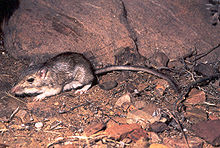
Heteromyidae is a family of rodents consisting of kangaroo rats, kangaroo mice, pocket mice and spiny pocket mice. Most heteromyids live in complex burrows within the deserts and grasslands of western North America, though species within the genus Heteromys are also found in forests and their range extends as far south as northern South America. They feed mostly on seeds and other plant parts, which they carry in their fur-lined cheek pouches to their burrows.
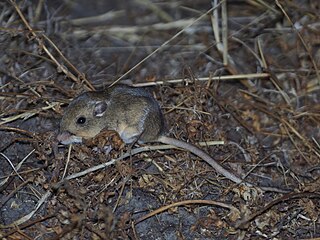
Perognathus is a genus of pocket mouse. Like other members of their family they are more closely related to pocket gophers than to true mice.

Perognathinae is a subfamily of rodents consisting of two genera of pocket mice. Most species live in complex burrows within the deserts and grasslands of western North America, They feed mostly on seeds and other plant parts, which they carry in their fur-lined cheek pouches to their burrows.
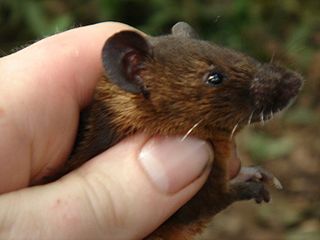
The brush-furred mice, genus Lophuromys are a group of rodents found in sub-Saharan Africa. They are members of the subfamily Deomyinae, a group only identifiable through molecular analysis. Lophuromys is also known as the brush-furred rats, harsh-furred rats or coarse-haired mice.
The link rat is a species of rodent in the family Muridae. It is also known by the common name Congo forest mouse. It is native to central Africa.

The rock pocket mouse is one of 19 species of pocket mice in the genus Chaetodipus. It is sometimes grouped in the genus Perognathus.

Mice in the genus Dendromus are commonly referred to as African climbing mice or tree mice, although these terms are often used to describe all members of the subfamily Dendromurinae. The genus is currently restricted to sub-Saharan Africa, but fossils classified in the genus have been found from Late Miocene deposits in Arabia and Europe.
Chiruromys is a genus of Old World mouse that is restricted to New Guinea and the nearby islands of Goodenough, Fergusson, and Normanby.

Chiropodomys is a genus of Old World rats and mice native to Southeast Asia and northeast India. They are tree-dwelling, very small mice, mostly found in tropical rainforest. In total six extant species have been identified, but only one of these, Chiropodomys gliroides, is common and widely distributed, and has been extensively studied.
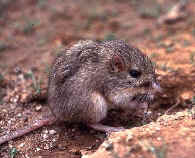
The desert pocket mouse is a North American species of heteromyid rodent found in the southwestern United States and Mexico. True to its common name, the medium-sized desert pocket mouse prefers sandy, sparsely vegetated desert environments.
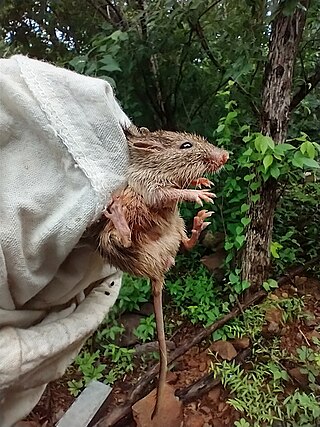
The narrow-skulled pocket mouse is a species of rodent in the family Heteromyidae. It is endemic to western Mexico, living west of the Sierra Madre Occidental crest.

Bailey's pocket mouse is a species of rodent of the subfamily Perognathinae, family Heteromyidae. It is found in Baja California, Sinaloa and Sonora in Mexico and in California, Arizona and New Mexico in the United States.
Goldman's pocket mouse is a species of rodent in the family Heteromyidae. It is endemic to Mexico, where it is threatened by the increasing conversion of its dry, scrubby habitat into agricultural land. As a result, the International Union for Conservation of Nature has assessed its conservation status as being "near threatened".

The Sinaloan pocket mouse is one of 17 species of pocket mice in the genus Chaetodipus. Two subspecies of C. pernix are recognized, C. p. pernix and C. p. rostratus, all are endemic to Mexico.

The spiny pocket mouse is a species of rodent in the family Heteromyidae and order Rodentia. It is found in Baja California in Mexico and in Arizona, California and Nevada.

Heteromys is a genus of rodents in the family Heteromyidae, commonly known as spiny pocket mice. It is the only extant genus in the subfamily Heteromyinae which also includes the extinct genera Diprionomys and Metaliomys. Heteromys was recently enlarged by inclusion of the members of formerly recognized heteromyine genus Liomys, which was found to be paraphyletic.

The Chihuahuan pocket mouse is a species of heteromyid rodent found in the southwestern United States and Mexico. It was formerly considered a subspecies of the desert pocket mouse, but was determined to be a distinct species in 1996, following analysis of its mitochondrial DNA.
The lined pocket mouse is a species of rodent in the family Heteromyidae. This pocket mouse is endemic to a small area of central Mexico.
